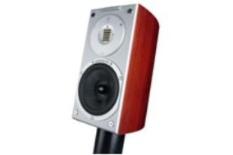What Hi-Fi? Verdict
The Avantgarde’s uneven range of abilities means they won’t suit all tastes, but at their best they are stunning
Pros
- +
Speed, agility and dynamics are all first class
- +
impressive resolution
- +
crisp stereo imaging
- +
upgrade potential
Cons
- -
Presentation lacks a little warmth and authority
Why you can trust What Hi-Fi?
Danish speaker specialist Audiovector has an interesting approach to design. It makes a full range of speakers, from standmounters to subwoofers, but has only a single cabinet design for each type. The cabinet is then equipped with varying grades of drive unit and crossover to make up a range.
This engineering approach makes upgrading easy. All you have to do to get a better sound is replace the drivers and crossover with those from a model above.
This is done at the factory and costs the difference in price between the two models, plus another 30 per cent to cover costs. The S1 standmounter range kicks off at £1175 and goes up to £3500 for the range-topper.
Audiovector takes speed and dynamics very seriously. To this end this speaker's mid/bass driver has a light diaphragm, good heat dissipation and an open chassis design to reduce compression at high volumes.
The tweeter is special, too. Ribbon tweeters are a rarity, and good ones produce a fast, crisp and detailed sound that's hard to get any other way.
In this case the tweeter's rearward output is fired out of a hole in the back of the cabinet. Not only does this allow the unit extra dynamic freedom, it creates a wider spread of sound, making stereo imaging more convincing.
Simple circuit has useful benefits
The speaker's crossover is extremely minimalist, having just one component in line with each drive unit. The potential advantages of such a simple circuit are improved punch, dynamics and detail.
This purist approach to crossover design is difficult to get right, as it places high demands on the drive units to ensure a well-balanced sound.
The use of a ribbon tweeter makes integration even harder to accomplish, so it's no small compliment for us to say that Audiovector has got it mostly right, even if the tonal balance veers towards being lean in the midrange and dry overall.
These monitors are effortlessly forceful in their presentation. Feed them Timbaland's Shock Value II and they'll charge along with glee. Low frequencies have a pleasing kick, while the rest of the frequency range brims with agility and insight.
The S1s are deeply impressive in the way they define the leading and trailing edges of notes: their precise delivery makes most rivals sound blurred in comparison.
They keep the music in check
No matter how complex the music, these S1s keep it all in check. Some may find all the control a little overbearing, robbing as it does a little of the music's flow.
But the benefits are obvious when it comes to insight. In addition, these speakers have little to fear from any rival when asked to unravel a complex recording.
They uncover much information and deliver it in a cohesive manner. Even the most demanding of rhythms – think Stravinsky's The Rite of Spring or Radiohead's 15 Step – make musical sense.
When it comes to managing precision and complexity, few speakers can compete. But there are shortcomings. The S1s are not particularly good at communicating music's natural warmth or muscularity.
Small-scale recordings like The XX's Stars lose intimacy, while grander productions such as Holst's Mars also suffer as a result.
Partner with top-class amps
Like most standmounters, the S1s benefit from a rigid stand. And as with any quality speaker you'll need top-class sources and amplification. The amp doesn't necessarily need masses of power – we got fine results with Unison Research's 35 Watt per channel S9 integrated – but quality has to be spot on.
Take the time to pamper the S1 Avantgardes with an appropriate system, careful positioning (away from all walls with a degree of toe-in towards the listening position) and rigid stands, and you'll end up with impressively accomplished stereo imaging.
The speaker layers the soundstage beautifully and delivers exceptional image precision.
There's no denying this Audiovector's talents. If speed, agility and dynamics are your thing, they're in pole position at this price level.
See all our hi-fi speaker Best Buys
Follow whathifi.com on Twitter
What Hi-Fi?, founded in 1976, is the world's leading independent guide to buying and owning hi-fi and home entertainment products. Our comprehensive tests help you buy the very best for your money, with our advice sections giving you step-by-step information on how to get even more from your music and movies. Everything is tested by our dedicated team of in-house reviewers in our custom-built test rooms in London, Reading and Bath. Our coveted five-star rating and Awards are recognised all over the world as the ultimate seal of approval, so you can buy with absolute confidence.


